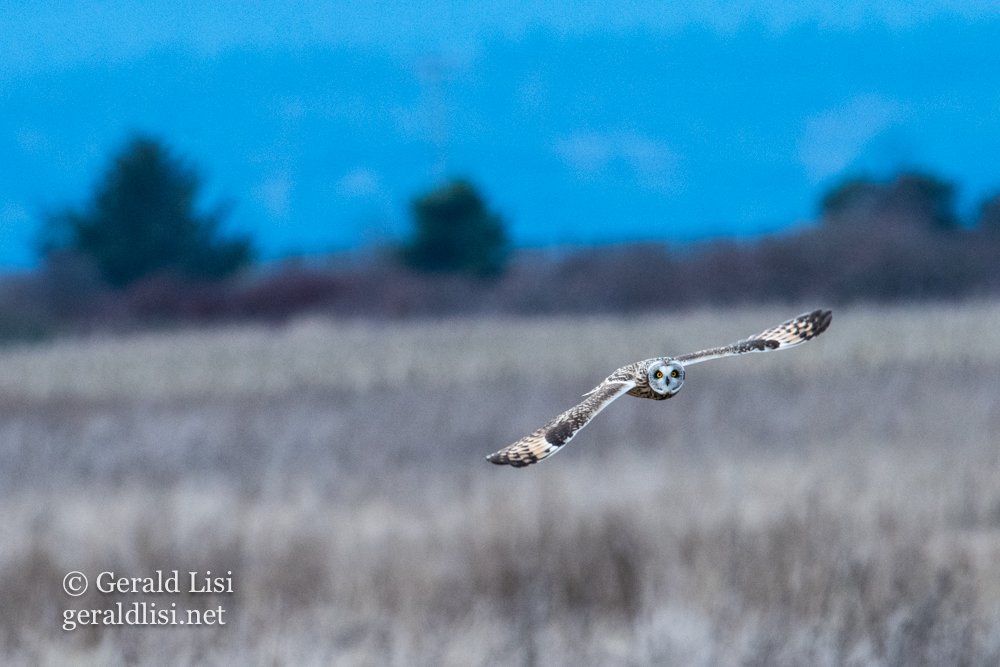Short-eared Owls and "Friends"
Short-eared Owl, Asio flammeus.
Short-eared Owls, Asio flammeus, are a medium-sized owl found across much of the world. As denizens of grasslands and other open habitats, the heavily-forested Pacific Northwest coast long had little to offer these owls, but land conversion for agriculture has created habitat for them in the Puget Trough. Here they are considered fairly common, while in other regions of Washington they are uncommon, rare or absent (birdweb.org). The attraction of wet, grassy fields in places like the Skagit Valley is an abundance of voles. Short-eared Owls also eat mice, and some other, larger small mammals. But, here it’s all about the voles, most likely Townsend’s Voles in most cases, which are far larger than any mice I know of.
My friend and I have visited this particular spot in search of Short-eared Owls every winter for the last few years. This has yielded some distant spottings and a whole lot of nothing, but our timing was spot on this occasion. As we rounded the bend there were rows of cars parked on each side of the road, and people with long lenses, spotting scopes and binoculars standing beside them. While I have no affinity for crowd birding my distaste was quickly overrun by the excitement of seeing the owl pictured above right by the side of the road. Amazingly there was a parking space directly across the road. As soon as I parked we high fived and got our cameras out. Some pictures were taken from the car, and when we saw that the owl seemed in no rush to leave we got out for better and different views. Below are my highlights from this spectacular afternoon of birding.
Taking off to look, or more aptly listen, for voles. Their facial disk creates the flat appearance of their face in profile. This feather arrangement, which is seen in many owl species, acts as a dish that routes sounds to owls’ ears on the sides of their heads.
After a brief flight the owl settled onto another perch. A dead thistle stalk in this case. The fact that it easily supports this owl drives home how light they actually are. When we look at birds most of what we see is feathers. The ever-so-subtle “ears” in these owls’ name are somewhat apparent in this shot. In contrast, the namesake tufts on the closely related Long-eared Owl are highly conspicuous.
Before I share more owl photos with you let’s look at some of the “friends” mentioned in the title. I use quotes because Short-eared Owls don’t seem to have friends, with the possible exception of their mates and young during breeding season.
“I just flew in from the Lower Cretaceous and boy are my arms tired.” Apologies to my social media followers who already saw this caption with the frame taken right after this one. That’s a slightly sharper photo, and a more flattering picture of this Great Blue Heron, but this one highlights a fascinating bit of bird anatomy. As this heron let out their Pterodactyl gronk they revealed the jointed bones of their lower mandible. Various long-billed birds have jointed beak bones that serve them in various ways. In the case of Great Blue Herons it helps them to swallow the astonishingly enormous prey they sometimes capture. I once watched one swallow a huge catfish over the course of about five minutes. I didn’t think they would get it down, but they sure showed me.
This Great Blue Heron was here for the same reason as the Short-eared Owl: voles. While they are wading bird that hunt fish and other prey in the water it’s not uncommon to see Great Blues hunting in fields for rodents, and snakes in the warmer months. In the case of winter vole and mice hunting this makes them competitors with Short-eared Owls, but the owls seem to ignore this particular competitor.
A pair of Trumpeter Swans from a nearby grazing flock fly by. Short-eared Owls are likely indifferent to these giant vegetarians, but I was excited to see them flying low only twenty feet away.
One more Trumpeter shot. They are a major winter birding highlight here.
Can you guess what this Northern Harrier is after? Yes, it’s voles, and the overlapping ecological niches of Northern Harriers and Short-eared Owls makes them bitter enemies. Not only are they hunting the same prey in the same place at the same time, but they regularly attempt to steal that prey from each other after it’s captured. As members of the hawk family Harriers have a remarkable bit of evolutionary convergence with owls. While it’s less pronounced than in owls, they do in fact have facial disks. Because voles tunnel under fallen dead grass sound is a more reliable way of locating them than sight.
Perhaps the worst enemy of a Short-eared Owl is another member of its own species. This heavily-cropped image shows a typical attack on an interloper. While there were several Shorties present they mostly seemed to partition the field into separate hunting grounds.
Now I leave you with a few more owl flight shots. As the grey afternoon got darker my simple kit’s capabilities were increasingly challenged, but I did get several flight shots that I like. Enjoy!
That’s it for now, folks! Thanks so much for joining me. I hope you found some beauty and inspiration in these images, and that you learned a thing or two. To receive my monthly blogs as newsletters please enter your email address at https://www.geraldlisi.net/
Until next time, take care of yourselves, each other, and the land that you live on.














